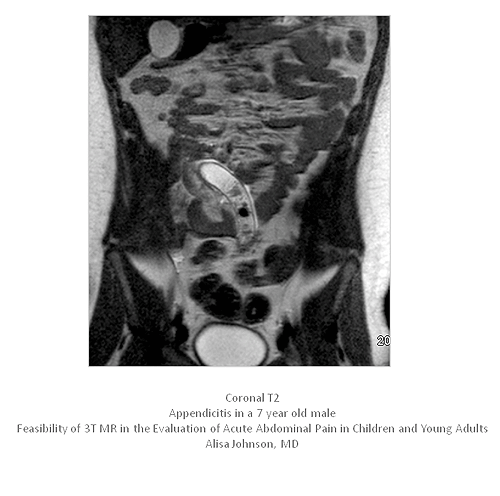Three-T MRI triages kids with acute abdominal pain
Results of a study by University of Vermont researchers suggest that 3T MRI should be considered as an alternative to CT in the evaluation of pediatric and young adult patients presenting to the emergency room with acute abdominal pain.
Results of a study by University of Vermont researchers suggest that 3T MRI should be considered as an alternative to CT in the evaluation of pediatric and young adult patients presenting to the emergency room with acute abdominal pain.
The Centers for Disease Control and Prevention recorded more than 100 million visits to emergency rooms in 2005, most of them due to abdominal pain. According to CDC data, a significant number of patients presenting with these symptoms underwent either ultrasound or CT scanning.
Recent studies have warned of an increased risk to the pediatric population due to CT overutilization. MR parallel imaging at 3T may be not only a safer bet than CT by keeping young patients from unnecessary ionizing radiation. It may also be more cost-effective, said coauthor Dr. Alisa K. Johnson.
"Pediatric patients who come to the emergency room with lower abdominal pain are often getting CTs," Johnson said in an interview with Diagnostic Imaging. "We are offering a fast, efficacious, and safe imaging modality with no ionizing radiation, no contrast, and no sedation."
Johnson and colleagues prospectively enrolled 23 patients with acute abdominal pain. Patients underwent free-breathing 3T parallel scanning with a 16-channel torso coil and short T1- and T2-weighted single-shot spin-echo sequences in three planes. All patients also had a CT and an ultrasound within 24 hours of MRI. Four radiologists interpreted studies in blinded fashion. Scan times ranged from two to seven minutes.
The 3T MR protocol accurately diagnosed 11 of 14 patients with true pathologies, which included abdominal abscesses, appendicitis, colitis, and mesenteric cysts. The investigators also found MR could help identify mesenteric adenitis, a mild condition that usually resolves without treatment. Johnson released her group's findings at the 2008 RSNA meeting.
MR time does not come cheaply, and researchers took that factor to heart when performing the study, Johnson said. Noncontrast scanning using a simple, fast sequence without sedation brings costs down considerably. It is also kind to patients in pain by avoiding breath-holds or ultrasound-like compression studies.
Patients avoid filling up with oral contrast, another plus for those with appendicitis, who might need to be rushed to the operating room, she said.
"Three-T MR is an excellent modality for evaluating acute abdominal pain for treatable conditions in children and adults," Johnson said. "It can diagnose multiple pathologies that cause right lower quadrant pain, which are often suspected as appendicitis."

Could Ultrafast MRI Enhance Detection of Malignant Foci for Breast Cancer?
April 10th 2025In a new study involving over 120 women, nearly two-thirds of whom had a family history of breast cancer, ultrafast MRI findings revealed a 5 percent increase in malignancy risk for each second increase in the difference between lesion and background parenchymal enhancement (BPE) time to enhancement (TTE).
MRI Study Suggests Shape of White Matter Hyperintensities May Be Predictive of Cognitive Decline
April 7th 2025Emerging research demonstrated that cognitive declines in memory, executive function and processing speed domains were associated with irregular shape of periventricular/confluent white matter hyperintensities.
Can Abbreviated MRI Have an Impact in Rectal Cancer Staging?
April 4th 2025Abbreviated MRI demonstrated a 95.3 percent specificity for rectal cancer and provided strong agreement with the full MRI protocol for T staging and detection of extramural venous invasion, according to newly published research.